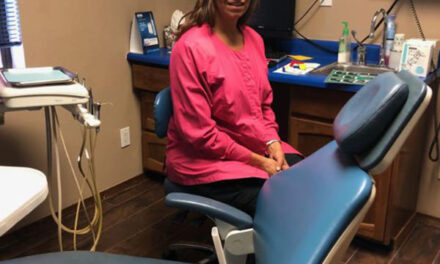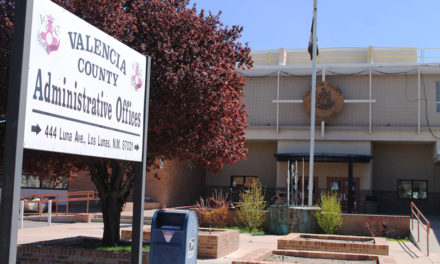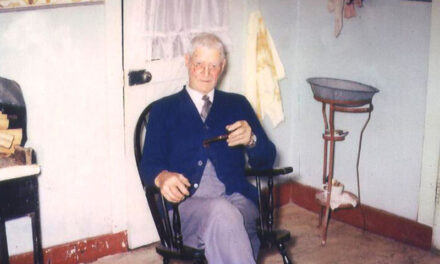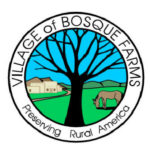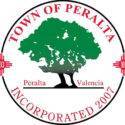Will oil and natural gas drilling come to Valencia County?
With the 3-1 approval of a natural resource overlay zone by Valencia County commissioners, it’s a possibility.
It’s an idea that doesn’t sit well with at least two county residents who were at the May 4 commission meeting.
During the public hearing at that meeting, Kathy McCord, who lives in El Cerro, said the term “natural resource overlay zone” wasn’t clearly defined to the public.
County attorney Dave Pato said the title and general description of the ordinance had been published in a legal ad, along with instructions on how get a copy of the draft ordinance.
Duana Draszkiewicz, a resident of the unincorporated part of the county north of Tomé, argued the legal ad didn’t “tell anyone anything.”
In the agenda request form, under the legal section, it’s noted per state statute, the title and general summary of a proposed ordinance needs to be published in a newspaper of general circulation in the county at least once a week for two consecutive weeks before the meeting at which the ordinance will be considered.
According to the documentation provided in the commission’s informational packet for the draft ordinance, a legal advertisement regarding the ordinance was published only once on April 15, in the Albuquerque Journal, which is considered a paper of general circulation for Valencia County.
Valencia County: Natural Resource Overlay Zone ordinance agenda request form, legal ad (2022)
Pato suggested the commission swear in the two women so they could give testimony at that time. The only other member of the public who had been sworn in for the hearing up until then was Harvey Yates Jr., of Albuquerque.
Yates Jr. and his family are well-known in New Mexico for the several oil companies they operate, and he is the former chairman of the Republican Party of New Mexico.
McCord admitted she was uneducated on the issue of oil and natural gas drilling, but offered the opinion that a lot of people in Valencia County were also uneducated on the issue.
“Which might make a decision tonight premature, with (this) public hearing and then shortly a vote,” McCord said. “This feels like fracking and drilling, going out under other people’s property. This is concerning. It sounds like you are possibly opening the door to something people of the county would not like.”
Pato said the overlay zone doesn’t allow extraction of natural gas, oil and other minerals in every instance.
“This would apply the same standards as for any other zone change. It has to be consistent with the (county’s) comprehensive plan, fit with the area, is good for the health, safety and welfare of the community,” Pato said. “This is creating a process. It doesn’t foreclose the opportunity for public to comment on any given application.”
An overlay zone allows activity on a property that isn’t allowed under its existing zoning, but leaves the original zoning in place while the new activity takes place.
For instance, the county has a solar overlay zone that allows solar facilities to be built on land that isn’t zoned for power production. A piece of property could be zoned as residential, so instead of rezoning it to industrial, the overlay zone allows the solar facility to operate and once it’s decommissioned, the property is still zoned for the less intense use of residential.
To get an overlay zone placed on a piece of property, a property owner or their representative has to apply, go through a public hearing in front of the county’s planning and zoning commission, which issues a recommendation, before it goes to the county commission for a second public hearing and a final vote.
Draszkiewicz said she was concerned the commission was opening a door to environmental consequences it wasn’t addressing.
“We have enough gas and oil. It is being stored; they’re not selling it and pushing prices up,” Draszkiewicz said. “You’re looking at environmental disasters like water pollution, death of birds, and animals and people due to air pollution. … You need to think long and hard on this.”
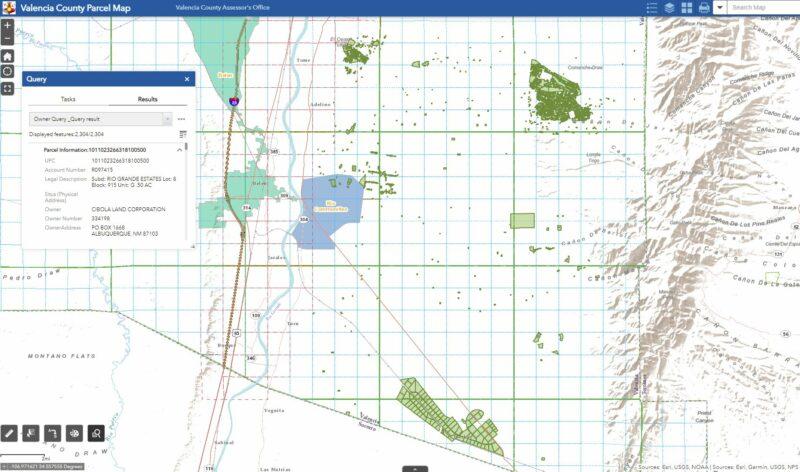
Source: Valencia County assessor’s office online parcel map
The properties highlighted in green are owned by Cibola Land Corporation. Harvey Hates Jr., a high profile businessman in the gas and oil industry in New Mexico, is president of the company.
Yates Jr. said the act of fracking — or fracturing rock in a vertical shaft to extract oil and gas — was misunderstood and often confused with horizontal drilling. He said fracking goes back to before World War II, when nigroglycerin was dropped down a well to get more oil and gas.
“In World War II, they developed better hydrology techniques. After that, they started hydraulically fracking, where they put specific zones under (water) pressure,” Yates Jr. said. “We’ve been doing hydraulic fracking since the 1950s …
“You talked about disasters. Oil and gas produces 40 percent of the revenue for the state. If we pull out, that’s a disaster. There have been attempts in Valencia County, going back to World War I, to see if there is something here. I think this will develop a new industry and create a better economy for Valencia County.”
Draszkiewicz said the commissioners needed to look at what’s happened in New Mexico and Texas when wells have been “exhausted and abandoned. I am pleading with you to have a meeting to have experts come forward.”
Pato began to explain there was a section of the ordinance that requires reclamation and restoration of the property, but Draszkiewicz left the room, throwing over her shoulder at the commissioners, “You’re getting (expletive) over.”
Valencia County: Natural Resource Overlay Zone ordinance (2022)
Commission Chairman Gerard Saiz asked if there was interest in exploration of natural resources in the county, saying he hadn’t heard it come up before.
Pato said he didn’t think so, but noted there are a limited number of mineral resource districts in Valencia County that would allow for exploration and extraction of oil and gas.
“In light of current costs and the need for domestic production, I think there would be interest to explore this,” the attorney said.
Commissioner David Hyder asked why the draft NROZ let applicants reapply for the overlay 90 days after a denial whereas regular zone change and overlay requests had to wait a year to come back.
“If we’re going to have consistency, it should be a year,” Hyder said.
Saiz agreed, and Pato changed the reapplication wait time to one year.
When asked by Commissioner Jhonathan Aragon whether he saw a need for this particular type of overlay, Yates Jr. said he did.
“Without the overlay, it appears there won’t be exploration,” he said.
Aragon asked if the county would get revenue from any oil and gas found in the county. Yates Jr. said if drilling was successful, the county would receive revenue.
Aragon made a motion to approve the NROZ, with a second from Commissioner Joseph Bizzell, who sponsored the agenda item.
Hyder voted “no” on the motion, while Aragon, Bizzell and Saiz voted in favor. Commissioner Troy Richardson was not at the May 4 meeting.
After the vote, Saiz said the ordinance would give some protection to the county, noting the approval did not grant anyone permission to drill and there was still an application process to go through.
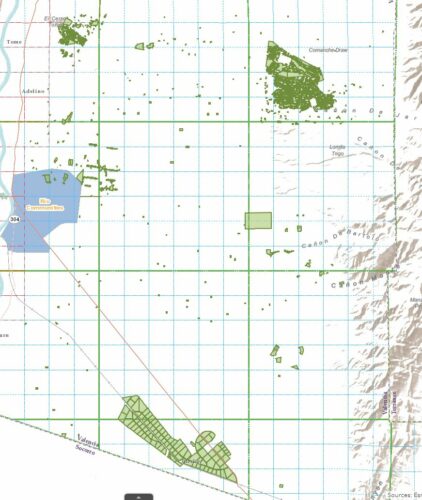
Source: Valencia County assessor’s office online parcel map
The properties highlighted in green are owned by Cibola Land Corporation. Harvey Hates Jr., a high profile businessman in the gas and oil industry in New Mexico, is president of the company.
The NROZ does exclude certain parts of the county from even the application process, declaring land within the boundary of the Middle Rio Grande Conservancy District that has been defined as the greenbelt by the county may not be included in a natural resource overlay zone.
County zoning ordinance defines the greenbelt as, “The area of land in the middle [sic] Rio Grande Valley, including the land east of the Belen Highline canal up to and including the Chical Highline canal on the east side of the Rio Grande River.”
The Belen Highline, on the west side of the river, runs the full north-south length of the county. The Chical Lateral, on the east, starts on the north end of the county near the Pueblo of Isleta and goes south until it turns west and crosses Sand Hill Road north of Tomé Hill, where it becomes part of La Constancia Lateral.
In the approved ordinance, there is language directing the planning and zoning commission on how to review and evaluate applications for the overlay zone.
The ordinance reads that any determination that a proposed NROZ will be detrimental to health, safety or general welfare must be specific in nature and must be related to the proposed location of the NROZ and cannot be based on generic and speculative harms.
“In making this determination, the planning and zoning commission must also consider the advantages from the successful development of the natural resource at the proposed NROZ site, including but not limited to the increased economic vitality of county, the potential jobs created and the potential increase in county tax revenue,” the ordinance reads.
Neither the county’s solar overlay zone ordinance, passed in 2014, or it’s more recent overlay zone for greenhouses, approved last year, contains these directives.
A review of county property records shows Yates Jr. and companies he’s associated with own about 7,200 acres in Valencia County. The lots range in size from a quarter acre to more than 100 acres, the majority of which are owned by Cibola Land Company. Yates Jr. is listed as the registered agent and president for the company.
The approximate 5,900 acres owned by the company is comprised of 2,304 parcels, which includes a group in the far southeast part of the county in Tierra Grande, a large cluster along North and South El Cerro Loop, east of Valencia High School, as well as two large parcels north of the high school, two parcels in the city of Rio Communities and 34.4 acres on the southeast corner of Sand Hill Road and North Del Oro Loop, directly east of Tomé Hill.
According to its website, Cibola Land Corporation is a real estate developer — formerly known as Cibola Energy Corp., which also owns land in the county — that is headquartered in Albuquerque and has been a family-owned and operated business for the past 30 years.
Julia M. Dendinger began working at the VCNB in 2006. She covers Valencia County government, Belen Consolidated Schools and the village of Bosque Farms. She is a member of the Society of Professional Journalists Rio Grande chapter’s board of directors.

